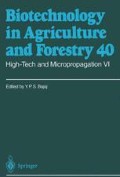Abstract
The genus Campanula comprises approximately 300 species distributed across the Northern Hemisphere (Cook 1951), many of these in mountainous areas. The genus generally inhabits meadow and subalpine regions, many species requiring full sun for optimal development. All species are herbaceous, and the name refers to the blue, bell-shaped flowers of the majority of the species. They are perennials, biannuals, or annuals. The growth pattern is characterized by a distinct vegetative phase, often with development of rosettes, and a generative phase, induced by long photoperiods, vernalization, or both, where the rosettes develop into multi- or single-flowering inflorescences. Usually, a flowering shoot dies after seed maturation. In biannual and annual species each seedling usually forms one rosette. The perennial species develop sideshoots or more or less underground runners each of which becomes a rosette during the following growth season.
Access this chapter
Tax calculation will be finalised at checkout
Purchases are for personal use only
Preview
Unable to display preview. Download preview PDF.
References
Brandt K (1992) Micropropagation of Campanula isophylla Moretti. Plant Cell Tissue Organ Cult 29: 31–36
Brandt K (1994) Variation among and within clones in formation of roots and shoots during micropropagation of Campanula isophylla. Plant Cell Tissue Organ Cult 39: 63–68
Brandt K, Ishimaru K (1997) Campanula species: In vitro culture, micropropagation, and the production of anthocyanins, polyacetylenes and other secondary metabolites. In: Bajaj YPS (ed) Biotechnology in agriculture and forestry, vol 41. Medicinal and aromatic plants X. Springer, Berlin Heidelberg New York (in press)
Cook HC (1951) Campanulas, their cultivation and classification. Theophrastus, Sakonnet (Reprinted 1977)
Fahrenkrog PS (1983) Untersuchungen zur in vitro Vermehrung und Organogenese bei Campanula pyramidalis. Thesis, Hannover Universityf
Heide OM (1965) Campanula isophylla som langdagsplante. Gartneryrket 55: 210–212
Horn W, Kintz H, Meier K (1988) Der Einfluß verschiedenartiger Leuchtstoflampen auf die in vitro-Organogenese von Kalanchoë-Hybriden. Gartenbauwissenschaft 53: 103–110
Kristiansen K (1988) Light quality regulates flower initiation, differentiation and development of Campanula carpatica Jacq. Karl Forster. Sci Hortic 35: 275–283
Moe R, Andersen AS (1988) Stock plant environment and subsequent adventitious rooting. In: Davis TD, Haissig BE, Sankhla N (eds) Adventious root formation in cuttings. Dioscoride Press, Portland, Oregon, pp 11–28
Murashige T, Skoog F (1962) A revised medium for rapid growth and bio-assays with tobacco tissue cultures. Physiol Plant 15: 473–497
Mygind H (1986) Fusarium wilt in Campanula isophylla. Dan J Plant Soil Sci 90: 3–14
Ó Ríordáin F (ed) (1994) COST 87 Directory of European plant tissue culture laboratories. Commission of the European Communities
SAS Institute (1989) SAS/STAT User’s guide, version 6, 4th edn. SAS Institute Inc Cary, North Carolina
Thinggaard K (1994) Root rot in Campanula carpatica caused by Phytophthora cryptogea. Eur J Plant Pathol 101: 111–114
Zimmer K (1983) Campanula pyramidalis L. V. Photoperiode nach der Kühlung und Gibberellinsäure-Wirkungen. Gartenbauwissenschaft 48: 61–67
Author information
Authors and Affiliations
Editor information
Editors and Affiliations
Rights and permissions
Copyright information
© 1997 Springer-Verlag Berlin Heidelberg
About this chapter
Cite this chapter
Brandt, K. (1997). Micropropagation of Campanula . In: Bajaj, Y.P.S. (eds) High-Tech and Micropropagation VI. Biotechnology in Agriculture and Forestry, vol 40. Springer, Berlin, Heidelberg. https://doi.org/10.1007/978-3-662-03354-8_5
Download citation
DOI: https://doi.org/10.1007/978-3-662-03354-8_5
Publisher Name: Springer, Berlin, Heidelberg
Print ISBN: 978-3-642-08270-2
Online ISBN: 978-3-662-03354-8
eBook Packages: Springer Book Archive

